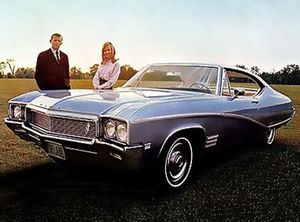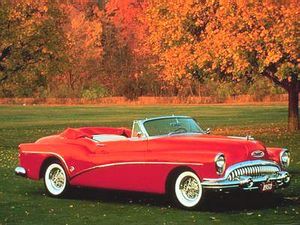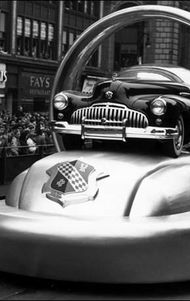.
Buick Skylark: Difference between revisions
24.42.76.64 (talk | contribs) |
24.42.76.64 (talk | contribs) |
||
| Line 87: | Line 87: | ||
* [[Buick V8 engine#215|215 in³ (3.5 L) V8]] | * [[Buick V8 engine#215|215 in³ (3.5 L) V8]] | ||
* [[Buick V8 engine#300|300 in³ (4.9 L) V8]] | * [[Buick V8 engine#300|300 in³ (4.9 L) V8]] | ||
* [[Buick V8 engine#350|350 in³ (5.7 L) V8]] | * [[Buick V8 engine#350|350 in³ (5.7 L) V8]] | ||
* [[Buick V8 engine#455|455 in³ (7.5 L) V8]] | * [[Buick V8 engine#455|455 in³ (7.5 L) V8]] | ||
{{-}} | {{-}} | ||
Revision as of 19:03, 29 May 2009
The Buick Skylark was a passenger car produced by the Buick division of General Motors. The model was made in six production runs. In each production, the car design varied quite dramatically. This was due to changing technology, changing tastes, and new standards being implemented over the years.
See Wikicars' comprehensive Buick_Skylark Review.
Recent Changes
Styles and Major Options
Gas Mileage
Reliability
Safety
Photos
Colors
Main Competitors
Unique Attributes
Resale Values
Criticisms
Seventh generation (YYYY–YYYY)
Sixth generation (YYYY–YYYY)
Fifth generation (YYYY–YYYY)
Sixth Generation (1980–YYYY)
Fifth Generation (1975–1979)
The Skylark was replaced by the Buick Century as Buick's redesigned intermediate car in 1973. The Skylark name was revived in 1975, when it was used as the name for Buick's X-body coupe. It replaced the Apollo name on that vehicle, although the Apollo name continued for the rest of that year on the X-body sedans. In 1976, the Skylark name totally replaced the Apollo name and was used for all the coupe, hatchback, and sedan bodystyles.
Fourth Generation (1968–1972)

| |
| Buick Skylark (1968-1972) | |
|---|---|
| Buick | |
| aka | |
| Production | 1968-1972, |
| Class | Mid-size Car |
| Body Style | 2-Door Convertible 2-Door Coupe 4-Door Sedan |
| Designer | Bill Mitchell and others at General Motors |
From 1968 through 1972, the Skylark was an intermediate "full-size" car according to U.S. EPA standards. The GS400 continued, and the GS340 was upgraded to GS350 status. There also was a GS350 California based on the Special post coupe; in 1967, it had been a regional trim package but now was nationwide.
In 1969, the Stage 1 was officially released (it had been a dealer-installed package in 1968), and in 1970, GM's ban on engine size and lb/hp was rescinded and Buick went nuts with the GS455 and GS Stage 1. These two, along with the GS350, continued on through 1972.
The GSX also was introduced in 1970. Similar to GTO's Judge, it came standard with the standard 455 and had the Stage 1 as an option. It was available in two colors - Saturn Yellow or Apollo White.
Starting in 1971, the GS became one package with the 350, 455, and Stage 1 as choices (rather than a separate GS350 and GS455). Likewise, the GSX was available with all three engines. Color choices for the GSX were increased as well.
Engines
Third Generation (1964–1967)
Beginning in 1965, the Skylark included the Gran Sport (GS) package, which included the Buick 401 in³ (6.6 L) V8, turning the Skylark into a muscle car. For 1967, a new 400 cid engine was introduced to replace the "Nailhead" 401.
Second Generation (1961–1963)

| |
| Buick Skylark (1961-1963) | |
|---|---|
| Buick | |
| aka | |
| Production | 1968-1972, |
| Class | Mid-size Car |
| Body Style | 2-Door Convertible 2-Door Coupe 4-Door Sedan |
| Designer | Bill Mitchell and others at General Motors |
The Skylark started as an upscale pillared-coupe based on the Buick Special, but after 1964 all of the newer intermediate models used the Skylark name.
Engines
First Generation (1953-1954)

| |
| Buick Skylark (1953-1954) | |
|---|---|
| Buick | |
| aka | |
| Production | 1953-1954, |
| Class | Luxury Convertible |
| Body Style | 2-Door Convertible |
| Designer | Harley Earl and others at General Motors |
Introduced to mark Buick's 50th anniversary, the Buick Skylark (first use of the name for a production vehicle) on one of three specialty convertibles produced in 1953 by General Motors; the other two were the Oldsmobile Fiesta and the Cadillac Eldorado. All three were limited production vehicles promoting General Motors' design leadership. Of the three, the Skylark had the most successful production run with 1,690 produced. This was considered quite an amazing sales feat, for the car had a list price in 1953 of slightly in excess of US$5,000. However, many languished in dealer showrooms and were sold at discount.
All 1,690 regular-production Skylarks built in 1953 (and all in 1954) were convertibles. The 1953s were based on the 2-door Roadmaster convertible, having identical dimensions (except height), almost identical convenience and appearance equipment, and a Roadmaster drive train. In 1953, the model designation for the Skylark was 76X, while the model designation for the Roadmaster convertible was 76R. The few options available to the Roadmaster convertible buyer were standard equipment to the Skylark buyer, albeit the base price for the well-equipped Roadmaster convertible was only about US$3,200.
The 1953 Skylark featured V8 power and a 12 volt electrical system, both a first for Buick, as well as full-cutout wheel openings, a styling cue that would make its way to the main 1954 Buick line. Also making its way into the 1954 Buick line was the cut-down door at the base of the side window line that bounced back up to trace around the rear window (or convertible top). This styling clue stayed with Buick for many years and can be found on any number of automobile brands to this day.
The 1953 Buick Skylark was a handmade car in many respects. The stampings for the hood, trunk lid and a portion of the convertible tub were the same as the 1953 Roadmaster convertible (and Super convertible, model 56R). The stampings for the front fenders, rear fenders, the outer doors, and a portion of the convertible tub were unique to the Skylark. All Skylark convertible tubs were finished with various amounts of lead filler. It is not unusual to find a substantial amount of lead filler just behind the doors near the bottom of the window line. The inner doors of the Skylark were made from the inner doors of the 2-door Roadmaster and Super by cutting the stamping in half approximately parallel with the ground and then welding the two pieces back together in a jig at an angle that produced the necessary door dip (see photos of finished car).
Although there were many unique design features of the 1953 Skylark, one that goes almost unnoticed today is that the top and seating of the car were lowered a few inches below the Roadmaster and Super convertibles. This was achieved not by changing the frame, body or suspension, but by cutting the windshield almost three inches shorter and lowering the side windows and convertible top frame. To accommodate people without bumping their heads with the top up, the seat frames and steering column were lowered.
The wheels of the 1953 Skylark were true wire wheels, produced by Kelsey-Hayes, with everything chromed save for the plated and painted "Skylark" center emblem. Although this was high style in 1953, the wheels were heavier than the regular steel wheels, would require periodic truing to keep them straight and balanced, and required tubes within the tires just when tubeless tires were becoming the norm, as they were throughout the rest of the Buick line.
For 1954, the Skylark returned, although radically restyled [1]. This Skylark featured elongated wheel cutouts, the interior of which were available painted a contrasting color to the body color. For example, black cars could receive white or red wheel wells. The trunk of the restyled Skylark was sloped into a semi-barrel shape. Tail lights were housed in large chromed fins that projected from the tops of the rear fenders.
The car was now based on the all-new shorter Century/Special chassis and not the top-of-the-line Roadmaster/Super chassis, also all-new for 1954. However, it did share the Roadmaster and Century powertrain, the highest output in the 1954 Buick model lineup. This powertrain was an evolutionary improvement, but very similar to the 1953 powertrain.
The model designation for the 1954 Buick Skylark was "100", a completely unique designation. The short wheelbase cars were the Buick Special: series 40, the Buick Century: series 60, and the Buick Skylark: series 100, albeit a series of just one model. All production Buick Skylarks were built as 2-door convertibles. They had the same luxury equipment as the 1953 Buick Skylarks.
Like their 1953 counterparts, the 1954 Skylark had a number of unique sheetmetal stampings, but without the hand labor that went into the 1953 Skylark production. In addition to unique front and rear fenders with the elongated wheel cutouts, the 1954 Skylark had a unique trunk with its semi-barrel shape and huge, rounded chrome fins. Interestingly, the hood was also unique to the 1954 Skylark in a small way. The hood ornament was quite different from all other Buick models for the 1954 model year. However, this same hood ornament, although unique in size to just this one model in 1954, was to portend the design of the 1955 Buick hood ornament used on all models of that year.
The cost of the Skylark, mixed with the public's dislike for the restyle and its perceived step down in rank to the Special/Century series versus the 1953 rank with the Super/Roadmaster series resulted in poor sales and the car's demise at the end of the 1954 model year.
Engines
Worldwide
Design quirks and oddities
Awards
See also
This article features content from the Wikipedia Buick Skylark page with these contributors

